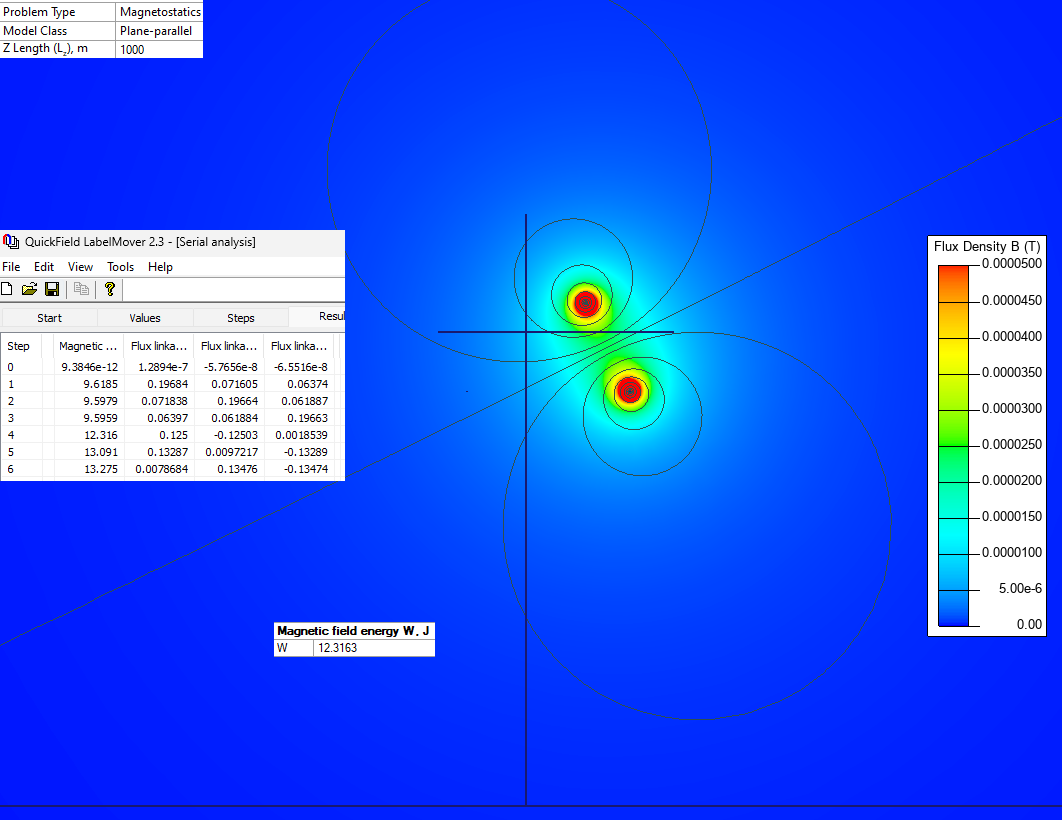Transmission line inductance matrix
QuickField simulation example
Transmission line consists of three phase conductors A, B, C placed above the earth. The single inductance value is not enough to describe this system. There are self inductance of each conductor and mutual inductance between conductors.
To understand the concept of mutual inductance you can think of some real case scenarios. For example, only phases A and B are energized and phase C is under maintenance and is grounded on both sides. The induced current in the C - ground loop depends on the mutual inductance between the C and other phase conductors.
In this example we calculate the transmission line inductance matrix.
Problem Type
Plane-parallel problem of DC magnetics.
Geometry
Given
ACC conductor* consists of 19 aluminum wires with a diameter of 3.447 mm each.
Task
Calculate the transmission line inductance matrix.
Solution
To measure inductance we energize one of the phase conductors and let the current return through the ground. Flux linkage with each conductor is measured. Then self- and mutual inductance values are calculated: Inductance = Flux linkage / Electric current.
Alternatively, we can measure energies. To measure the self inductance we energize one of the phase conductors and let the current return through the ground.
Inductance = 2 · Magnetic field energy / (Electric current)²
To calculate the mutual inductance we put forth and back current in two of three phase conductors. There is no current in the soil nor in the free phase conductor in this case.
This way the line-to-line loop inductance value is calculated. To convert it to the phase-to-phase mutual inductance the following equation** is used:
Lloop AB = LA + LB - 2·MA-B
This yelds MA-B = ½(LA + LB - Lloop AB)
Results
Calculations are done per 1 km of the transmission line length. Test electric current value is 100 A.
| Energized phase | Measured flux linkage, Wb/km | Inductance values, mH/km | ||||
|---|---|---|---|---|---|---|
| A | B | C | A | B | C | |
| A | 0.19684 | 0.07160 | 0.06374 | 1.968 | 0.716 | 0.637 |
| B | 0.19664 | 0.061887 | 1.966 | 0.618 | ||
| C | 0.19663 | 1.966 | ||||
| Energized phases | Measured energy, J/km | Self inductance L, mH/km | Loop inductance, mH/km | Phase-to-phase mutual inductance M, mH/km |
|---|---|---|---|---|
| A | 9.6185 | 1.923 | ||
| B | 9.5979 | 1.920 | ||
| C | 9.5979 | 1.920 | ||
| A+,B- | 12.316 | 2.463 | ½·(1.923+1.920-2.463) = = 0.690 | |
| A+,C- | 13.091 | 2.618 | ½·(1.923+1.920-2.618) = = 0.612 | |
| B+,C- | 13.275 | 2.655 | ½·(1.920+1.920-2.655) = = 0.592 |

References
* Daffodil, All Aluminum Stranded Conductor
** Clayton R. Paul Inductance: Loop and Partial, page 315 "Modeling a two-wire transmission line with partial inductances". ISBN-13: 978 0 4704 6188 4.
- Video: Transmission line inductance matrix
- Watch online on YouTube.
- Download simulation files (files may be viewed using any QuickField Edition).